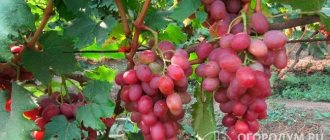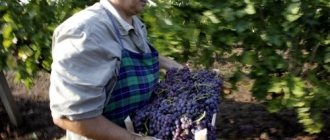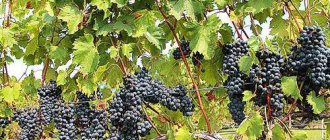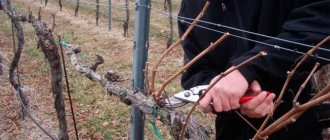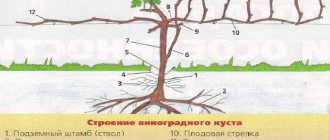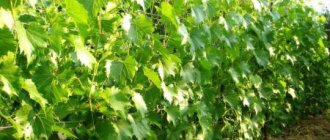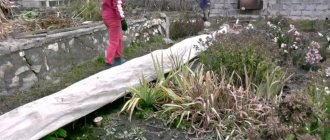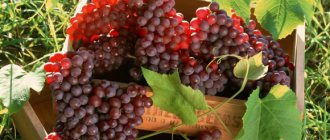A replacement shoot is a vine on which a few eyes have been left. Over time, new shoots will grow from these eyes. From them it will be possible to form another fruitful vine and a replacement shoot. This will allow you to get a harvest next season. If you adhere to this scheme, the grapes will bear fruit for many more years.
A replacement shoot is a vine on which a few eyes have been left
The role of shoot replacement in the fruit unit
The fruitful arrow and the replacement shoot are two absolutely identical vines. The only difference is the cutting length. The replacement shoot is called the replacement knot because it is short. Only 3 eyes are left on it. Of the two, you can get future vines, the third is a safety net.
The fruit shoot is also cut off. But they leave 6-8 eyes on it. In the spring, shoots will also grow from them, and in the summer it will be possible to harvest grapes. When the arrow fruits, it will need to be completely cut off. Out of 8-10 vines, you will have to leave only 2 that grew on a replacement knot. We also prune them, creating a fruitful shoot and a replacement shoot. And so on from year to year.
You can deviate from the classic diagram of fruit links. Instead of one arrow, two are formed. The most common formations:
- Fruit link with replacement shoot
- Fruit links without replacement knots
- Reinforced fruit link
- Diagram of a bush with short pruning of fruit shoots
Rules for grape formation
Like any other agrotechnical process, this one has clear algorithms of action or rules of formation:
- Of all the existing methods of forming a grape bush, you need to choose one or those that correspond to your site and the growing conditions of the crop.
- Strictly observe the seasonality of pruning and other procedures.
- Be sure to take into account natural conditions (climate, standard winters, etc.), and in addition to them, the location of the site and the varietal specifics of the vineyard.
A lot depends on how correctly the formation of grapes is carried out in the first year: plant growth, their resistance to disease, and finally, the harvest.
How to properly grow a bush using replacement shoots
Two vines should emerge from the seedling in the spring. One of them will need to be cut off, leaving 2-3 eyes. From the second one you can form a fruitful sleeve. In the fall, you will need to prune the vine so that there are from 5 to 15 shoots left on it, depending on the chosen variety and growing scheme.
Fruiting units are formed gradually
In subsequent years, we repeat the pruning procedure. Gradually, you need to form several fruit links. It is necessary to give the grape bush a certain shape. Only in the fourth year will such a bush begin to bear fruit. The arrow from which the harvest was harvested is completely cut off in the fall. You can shorten the replacement shoot only in the spring, since it is unknown how many buds will remain over the winter.
When forming and pruning a bush, you need to consider several important points. When the bush is rid of excess vines, wounds appear on it. They take a long time to overgrow and nutrients do not pass through them well. In order for the grapes to receive nutrition, wounds must be left on only one side of the sleeve. Then on the other there will be free ducts without damage.
The cuts should be made at an angle so that the flowing juice does not get on the young eyes. A flooded eye may not awaken, and the bud in it will die.
Trimming options
When forming grapes, attention is paid to favorable fruiting conditions not only for the coming season, but also for subsequent years. That is, each sleeve should have 1-4 fruit links. The function of the spare knot is to limit the growth of the crop, since without agrotechnical measures taken, the fruit-bearing areas of the bush will move away from the trunk and suffer from a lack of nutrients.
The crop needs to be pruned both in spring and autumn. At the beginning of the growing season, replacement branches are formed, and at the end, branches that have already completed fruiting are pruned. The formation itself varies:
- with removal of the replacement part;
- without removing the knot;
- pruning fruit shoots;
- strengthening the fruiting link.
Each of these schemes has pros and cons. They choose one, taking into account the varietal characteristics of the grapes: growth rate, yield, etc.
With knot removal
The main purpose of such removal is to create conditions for the formation of the fruiting arrow as a fruiting link. Trim it, leaving up to 15 buds on the vine. Renewing the arrow without a spare knot is done by trimming the shoot obtained from the first eye of the vine.
Already next fall, the remaining long branch can be pruned. Only 2 young shoots are left. Cut them short, into 2 buds. In subsequent years, the operation is repeated.
To avoid possible problems with damage to the shoot, it is better to leave another, spare shoot. If it is damaged by frost, the bush will not lose its chance of bearing fruit.
Without removing the knot
Pruning of grapes without knot replacement is carried out when 2 vines are formed on a young bush. One is cut into 3 eyes, and the second is made into a sleeve. At the end of the growing season, annual shoots are pruned. Only the 5-10 strongest are left. The rest are getting rid of.
With each subsequent year the procedure is repeated. The replacement knot is shortened only in the spring, and in the fall work is done with the resulting sleeve. So, every year, the bush will increase the number of fruit vines. The winegrower will only have to choose the appropriate form for it.
Trimming fruit shoots
It is important to form the bush correctly
This is the most popular type of formation among winegrowers. If done correctly, it will create good conditions for fruiting. It is used only for non-covering grape varieties. The main goal is to grow bark on the vine so that the berries are juicy and sweet.
Only 2-3 buds are left on each fruit link. A distance of 15-25 cm is maintained between the links. The distance varies by the number of arrows. The greater their number, the greater the distance between them. With this formation, the shoots will become sleeves in the future. In spring, the lower eye is cut into 3 buds. It will serve as a substitute knot.
Strengthening fruit links
Strengthening is the use of 2 fruitful arrows. They are tied up in order to later obtain 2 high-quality fruit-bearing vines. The winegrower’s task is to identify the strongest shoots that have formed. They are left and the weak ones are removed.
For knot replacement, the lower shoots on the fruiting link are used. The remaining second vine is removed. This pruning is considered convenient for those who grow covering crop varieties. It promotes the formation of a compact bush shape.
Like other pruning schemes, strengthening fruit links has both advantages and disadvantages. Among the advantages are a large number of green eyes. This will help determine the number of kidneys affected by frost. The disadvantage is that several green parts will have to be removed to comply with shaping rules. That is, the plant loses part of the nutrients spent on providing branches and shoots irrevocably.
What should I do if by mistake I messed up the replacement escape?
Sometimes you can prune a replacement shoot by mistake. What to do in such a situation? There are two ways out:
- We cut off damaged shoots; if some shoots have received a small amount of damage, we prune them for fruiting. After a year, these grape shoots also need to be pruned, leaving 1-2 of the strongest shoots from the head of the bush. The inflorescences on them need to be cut off. Such shoots can be used as replacement branches during pruning next fall. This path is universal for all grape varieties.
- We cut a strong shoot into a branch, and cut off a weak shoot completely. We take the fruit arrow and get rid of all last year's shoots of the fruit arrow. Although such an arrow will still be quite long in the coming years, we will have a good branch. This will protect us from accidental damage to grape shoots and from destruction by pests. This path is only suitable for high-yielding grape varieties.
Short pruning of grapes into horns
Pruning grapes into short fruiting horns (or knots) is the easiest to understand. It is used on different formations, but most often on cordon ones. The following picture shows a cordon shoulder with young, newly formed fruiting horns. All of them are trimmed into three buds:
Over the next summer, green shoots will sprout from each bud on the horns. The bush will look something like this:
The shoots in the figure are conventionally shown without leaves. By autumn they will ripen, become woody, and the time will come for the next pruning.
Grapes are pruned for fruiting according to the principle of replacement. After pruning, the bush should return to the same condition it was in a year ago, old fruiting vines should be replaced with new ones.
The following picture shows how to properly prune such a grape bush according to the principle of replacement. Red lines are cut locations. We will cut the lower vine into three buds and it will become a new fruiting horn, and we will remove everything above it.
As a result, the trimmed grape bush will look like this:
As you can see, everything is quite simple. A new fruiting knot formed from the lower vine replaced the old fruiting knot.
Grape bush without replacement shoots
In such a bush, only the fruiting arrow takes part in the formation of the fruit link. If the height of the trellis is 2 meters, then the best option would be to leave no more than 15 eyes on the vine. To renew a fruitful arrow without replacing a knot, use the shoot that is closest to the base of the vine.
It is best to leave two vines, since one of them may be damaged during the winter.
Over time, this sleeve will become longer. To avoid this, a fruitful vine can be formed from a shoot growing directly on the sleeve. It is best to leave two vines, since one of them may be damaged during the winter. It is necessary to complete the formation of a new fruit unit in the spring.
This formation of fruit shoots has a number of disadvantages. It is more difficult to arrange spare eyes than on a bush with replacement shoots. If there are several fruit-bearing vines, they have to be overlapped, which complicates the care of the plant.
Formation with strengthening of the fruit link
To enhance, two fruit arrows are used instead of one. They are tied horizontally to one trellis. Strengthening is achieved due to the fact that two vines with 6-8 buds each are grown at once. Then you can choose the strongest shoots that will bring the maximum yield. Unsuitable shoots should be removed as early as possible so as not to overload the bush. It is advisable not to overdo it with pruning grapes. Wounds on grapes take a long time to heal and weaken the nutrition of nearby eyes.
Shoots that are located at the base of the fruiting arrow are used as replacement knots. The second vine is completely disposed of. Here, too, you may encounter the problem of lengthening the sleeve. To renew the perennial vine, green shoots are used that appear in the spring from dormant buds.
Growing grapes this way has another advantage. It is convenient to cover it for the winter. It is enough in the fall, after pruning, to lay the vines on the ground and cover them with plastic film.
A reinforced link can be formed together with a separate replacement knot. Then the quality of the renewed vine increases, and the bush can bear fruit several times more efficiently.
What is a fruit arrow
A “fruit arrow” is an annual vine pruned into 4-5 buds. This vine is intended for fruiting. It is planned that from its buds in the spring of next year vines will grow, on which berries and fruits will further form.
In order for the vine to bear fruit, it itself and the shoots emerging from the buds are placed on a trellis horizontally to the ground. In this case, the vines stop their rapid growth and direct all their energy to forming a harvest.
OLYMPUS DIGITAL CAMERA
Shortening fruiting shoots
This form of fruit links is very popular. With the right agricultural technology, you can get berries of excellent quality. Such grapes are placed on arched, shelving supports. The shortening method is used only with non-covering varieties. With this pruning, perennial wood accumulates, and the grapes turn out sweeter.
The length of one fruit link is a maximum of 2-3 eyes. Several links are grown on one branch with an interval of 15 to 30 cm. The more shoots on one arrow, the greater the distance between the arrows.
To create this shape, shoots are grown on the branch, which will become future sleeves. In the spring they are cut off, leaving the required number of eyes. The shoot that grows from the first eye will become a replacement knot. All shoots that are located higher are pruned in the fall, when the harvest has already been harvested from them. If inflorescences do not form from the first buds, then short pruning cannot be used.
This shape of fruit links is very popular
It is very difficult to cover such grapes. The branches are massive, the annual vines are short and stiff. They cannot be covered with soil. Agrofibre and polyethylene will tear on the sharp ends of the vines.
Updating a sleeve when shoots do not appear on it
It often happens that a sleeve has grown in length, but it is not possible to form a new one. In order for a green shoot to appear on the sleeve, you need to thin out the eyes on the fruit shoot. Then the load on the grapes will decrease, and you will have the opportunity to update the sleeve with a new shoot. In the spring you can cut off the unnecessary part of the perennial vine.
Reanimation of replacement knots
Replacement knots are often pruned by mistake, without thinking about the consequences. In order not to destroy the plant, the procedure should be carried out according to the rules.
There are 2 action plans for resuscitation of replacement knots. The first one is the simplest.
- The most damaged shoots are removed.
- Slightly damaged shoots are pruned for fruiting.
- After a year, 1-2 of the strongest shoots are left.
- In autumn, the remaining parts of the plant are formed into a replacement knot.
This method of knot replacement is universal. If done correctly, it is suitable for both covered and non-covered grapes.
The technique of the second method is to shorten a strong shoot. They cut it into pieces. In the fall, all annual shoots will need to be removed from the fruit shoot. This scheme will also help maintain crop productivity, but is not suitable for all varieties. It is used only for grape varieties characterized by high yields.
Growing grapes is painstaking work, which is rewarded with a tasty and healthy harvest of berries. In order for the bushes to produce a large and high-quality harvest from year to year, you need to pay special attention to the issues of shaping and pruning. These procedures are aimed at harvesting high-quality fruit-bearing vines for the current season, as well as replacement shoots for the coming one.
The role of replacement shoots is very great. They allow you to renew the grapevine, which makes it possible to control the qualitative and quantitative indicators of yield.
Replacement shoots in the photo
